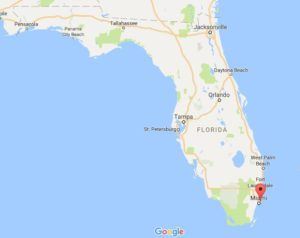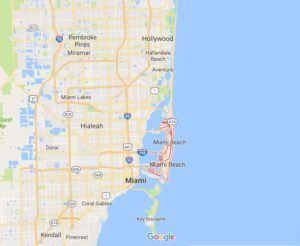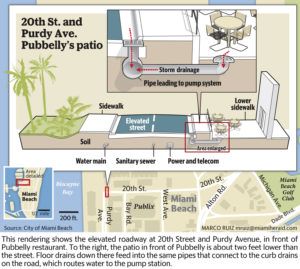Under Water: The City of Miami Beach

Miami Beach’s ocean-side location–the source of much of its charm–is becoming one of its greatest challenges as global sea levels continue to rise. The world watches as Miami Beach wrestles with this ever-growing challenge.
In brief:
Miami Beach is one of the United States’ most iconic cities. It has one of the most vibrant art and food scenes, has tremendous cultural diversity, and some of the nation’s most breathtaking beaches. Miami Beach’s ocean-side location–the source of much of its charm–is becoming one of its greatest challenges as global sea levels continue to rise. The world watches as Miami Beach struggles with this ever-growing challenge. Will it be successful? What can we learn?
Background:
The City of Miami Beach is an island stretching roughly 9 miles north to south just off the Florida coast separated from the mainland by Biscayne Bay. Though entrepreneurial coconut farmers and others had been trying to make good use of the land for decades, development began in earnest soon after a causeway connected it to the mainland in 1918. Before long, property developers covered the coast with hotels for tourists and mansions for the rich and famous, kicking off a property development boom that has never looked back. The rush of people from elsewhere in the US and Central American immigrants in the second half of the 20th century brought its population from 46 thousand in 1950 to nearly 2 million in the Miami area in 1990.
Today, the real estate market in Miami Beach one of the nation’s most expensive and frenetic. Many outside observers find this confusing–with an average elevation of 1.4m above sea level and seas expected to rise as much as ~2m by 2100, it is hard to imagine how property here could be considered a safe investment.
Despite still being technically “above water”, flooding related to rising sea levels has already started to strike the city. “Sunny-day flooding” is a phenomenon that has begun to appear during particular high tides in October and March, called “king tides”. These tides cause ocean water levels to reach a level above the drainage outflow pipes coming out of the city’s seawalls–salt water then flows up through the drains and gushes onto the city’s streets. City Engineer Bruce Mowry said the problem got so bad that “We literally had people paddling [in kayaks] on the streets”. Miami Beach’s mayor ran on a platform of helping Miami Beach withstand issues relating to rising sea levels and has delivered on that focus in office:
Solutions today:
Miami’s drainage system is being retrofitted with a valve and pump system that will block ocean water from coming in while pumping it’s waste water out. Flex valves (diagram below) function much like the valves separating ventricles and aorae in the heart do–flows can only move in one direction (outward, in this case). However, just as with a heart, in order for liquid to move through these valves in the right direction, it still needs to be pumped through.
The ~80 pumps in this project are expected to cost $400+ million, which is roughly equal to one year’s tax receipts for the city.
In addition to the new valve and pump system, the city is taking other measures. Elevating roads and sidewalks, for example, will funnel water more effectively into the drainage system (see below)
Additional solutions, such as raising the height of the city’s seawalls and sand dunes, and perhaps even cutting in canals, may be required to keep the fight going. Regulation requiring new real estate development to keep the lowest finished floor of buildings even higher than FEMA’s current flood safety requirements is being considered as well.
Looking to the future
Inevitably, however, the tools available today are still insufficient. As Vanity Fair summarizes after an interview with the city’s mayor, “By Levine’s estimation, [the currently planned and available measures] are buying Miami Beach 50 years, during which time, he is convinced, scientists will develop ingenious new ways to combat the problem.”
Some of the solution may extend beyond simple engineering. “Our current plan is how do we stay relatively dry for the next 30-50 years,” Says Jimmy Morales, a city manager. “the real long term issue is how do we create a sustainable community that includes our land use codes, our building codes and materials. Do we need to go to a landscaping plan that deals with more salt tolerant species? How do we help individual property owners? How do they raise their houses?…The early focus had been on the engineering solution, [but we also] need to think about our focus going forward”.
While the mix of engineering prowess and lifestyle adaptation will still need to bear itself out over the coming decades, Miami Beach’s smaller scale and relatively strong funding position it well to remain on the cutting edge of technological and policy solutions regarding how cities will deal with encroaching sea levels in the future.
(797 words)
Sources:
- http://www.miamibeach411.com/History/history_timeline_2.htm
- http://www.vanityfair.com/news/2015/11/miami-beach-global-warming
- http://therealdeal.com/miami/issues_articles/the-swelling-sea-level-debate/
- https://hi.stamen.com/south-florida-and-sea-level-the-case-of-miami-beach-f34b152f1801#.v6uihk6jg
- https://weather.com/science/environment/news/sea-level-rises-miami-doomed-20130625
- https://www.redfin.com/blog/2016/04/march-miami-housing-market-tracker.html
- http://www.nytimes.com/2016/02/23/science/sea-level-rise-global-warming-climate-change.html?_r=0
- http://www.miamiherald.com/news/local/community/miami-dade/miami-beach/article41141856.html







Great post on Miami. I think this is a topic that has begun to affect many other cities around the world, but Miami may be a vanguard for how cities can effectively respond to rising sea levels. I wonder if the city leadership studied New Orleans and what has worked/not worked as another very low-lying metropolis. For example, the post mentions the use of flood valves at the city’s sea walls, but these systems require pumps that can potentially fail during widespread electrical outages (such as during a hurricane). New Orleans uses these types of pumps, and many of them failed during Hurricane Katrina, despite electrical backups, and even during subsequent tropical storms, which led to sewage and toxic water back flows. Moreover, these valves probably fall into the short-term solutions category, which seems to accurately match the 30-50 year “temporary fix” timeline that you mentioned in your post. I wonder how scientists will address the “long-term” fix. Floating buildings and roads?
Although it is a huge financial investment, the retrofitting of the Miami drainage system with a value and pump system is absolutely necessary for the future of the city. One major concern that still remains, however, is the preservation of the beaches. The long, wide beach along the Atlantic coast is as much of a draw as Miami’s nightlife, restaurants and Latin culture. Additionally, many of the largest and most expensive hotel and restaurants that brings in economically-valuable tourists (e.g, Soho House, Le Fontaine Bleue) are located directly between the city streets and the beach. Even if they are protected from street flooding, rising sea levels will eventually compromise the beach and building infrastructures. I would argue that equal investment also be placed in rebuilding the beaches and installing rock/concrete barriers to reduce oceanic wave heights.
Interesting research about Miami Beach. Coming from Taiwan, a small island with frequent climate challenges such as earthquakes, volcano and typhoons, we always think about the rising of sea level. However, most people in Taiwan consider this a future problem and are not taking any action now. The initiatives took by Miami is a good reminder and lesson for Taiwanese government. It’s be worthwhile to come up with more proactive actions, for example, how we can prevent the sea level from rising so rapidly by doing global alliance etc on top of current actions.
Thank you for this extremely important post. Just a couple additional considerations: I think both rising sea levels *and* an increase in extreme weather events like hurricanes and tropical storms pose significant flooding threats for Miami. The city has already had to spend massive sums of money in the past to repair storm damage, and if climate change increases the likelihood of storms, this city may struggle to finance its own operations. The pump system project is incredibly important, and Miami may want to think about innovative financing solutions – potentially a public-private partnership – to implement it if the price tag is too burdensome on its own budget. Regulation on new development is also critical, although it will likely be fought by the real estate community, which may not have the same long-term perspective as the city. Tax incentives for flood safety might be a more feasible route to achieve the same end.
That’s a great point. One of the issues that came up as I researched for this was around whether anyone would be willing to insure these properties in the future. With sea levels coming from below and huge storms coming from above, it’s remains to be seen who will be willing to take that risk and at what price.
As far as the new developments are concerned, you’d think that anyone building in Miami Beach today would have water levels and hurricane damage front of mind–yet from what I read in writing this article, it’s been a total afterthought. Since developers and even many buyers expect to have exited their investments within the next several years, after which point it will be sold to another buyer with a short investment horizon, there is a shocking market failure in producing structuresthat are actually well positioned to handle these climate issues that are already coming to bear.
Fascinating topic on Miami Beach. I’m interested in how this study applies to so many other cities across the globe, as human civilizations have always been so dependent on settling near bodies of water, particularly oceans, bays, and rivers. I’m curious how many other cities are making similar efforts to address this problem, both in the short term and the long term, as it could quickly become a threatening reality for so many coastal cities, some with world wide impacts such as New York City or Boston. I wonder if any of these cities have shared their research or decided to work together to address an issue that was will face such a large portion of the globe so soon!!
Really great read, Spencer. I wonder what kind of assumptions the city is putting into its 30-50 year plan. At what point do future residents and businesses decide that it’s no longer worth staying in Miami. At that point, I could see a vicious cycle where an exodus drives up the tax burden on current residences/business which then incentivizes even more residents and businesses to leave. The same goes for tourism. At that point, will the city of Miami be able to save itself? Do they have as much time as they think? Hey! At least they still have Dwayne Wade!
Interesting post that applies to many places in the world. I agree with Casey that it would be interesting to understand at what point it is no longer feasible for Miami to exist. Having tried to build sand castles that could outlast the tide, engineering solutions only last so long… I looked up some of the predictions: 2025 [1] and 2045 [2]. However, all sites were consistent that it was too late for Miami [3].
[1] http://miami.cbslocal.com/2015/10/14/predictions-put-south-florida-under-water-by-2025/
[2] http://phys.org/news/2015-10-sea-swallow-miami-orleans.html
[3] http://sealevel.climatecentral.org/
Great post and interest (though depressing) read. The point brought up about Miami’s beaches in the comments is really interesting and one that crossed my mind as well when reading your article. All of the steps the city is taking now address disaster prevention but do not protect the parts of the city that drive its tourism and economy. Without its beaches and beachfront real estate how long can Miami continue to be a major US metropolis? Will climate change do to Miami what the auto crisis did to Detroit? If so, why are they not asking residents to change behavior now to reduce the speed of climate change going forward?
Great read, and sad to hear such a great city facing so much risk! I have read articles about Amsterdam and Venice, and they are actually considering a radical approach to deal with rising water levels: building gigantic dams all the way around the city a few kilometers into the ocean. These structures will keep the water levels directly around the city at current levels while the ocean levels continue to rise outside of the dams. Granted, this is highly risky, and it is arguably the same technique that has been leading to sea-level problems in New Orleans and Amsterdam for centuries. It is also significantly more expensive than the drainage updates you describe, but it’s a more extreme option that the city might consider if levels get so high that even a retrofitted sewage system can’t keep up.
One of the issues unique to Miami versus, say, New York or Amsterdam, is the underground geology. Miami is situated on top of a ton of limestone, a highly porous rock, which means that as sea levels rise, dams can only do so much. The ocean water will easily seep through the ground and start to appear everywhere.
To the point of Christine’s reply above, there are many differing perspectives on how much longer Miami Beach will last, but barring game-changing innovations in the future, there is strong consensus around the endpoint.
This article is very striking because I commonly hear about the effects of climate change and sea level rise discussed in the future tense. “What could happen….” “What will happen…” But this post reinforces that it is happening today! Many of the world’s most iconic cities are the most exposed to sea-level rise. Miami beach is a critically important city to South Florida’s tourism industry, real-estate market and overall economy. In a state like Florida with a conservative state government that doesn’t seem to act with policies that recognize the urgency of climate change, I wonder how the problems that Miami Beach is facing are driving the conversations and view points among state lawmakers. I hope that this catalyzes lawmakers to act through aggressive policies in addition to providing the funding to address the more short term fixes to keep Miami Beach dry.
Thanks for the interesting post! Having the sea level going up is the common issue for many islands and cities along the coast line, and most cities and islands take relatively passive attitudes toward to crisis. Miami is actively seeking a good way to ensure that the city can function as usual when the sea level going up, but I’m thinking that if there is any possibility that cities and islands can think about how to prevent it. For example, besides helping on reduce CO2 emission, can cities or islands actively set regulations to restrict companies located in these places to follow more strict regulations to improve the climate change issue? In addition, can cities or islands develop certain chemical materials to temporarily change local climate to slow down the sea level going up? By both innovating in the new solution and changing current living style, I believe cities and islands might eventually be able to survive in global warming.
Great read, Spencer. Saw the topic briefly referred to in Leo DiCaprio’s new movie on climate change (where he interviewed the mayor). Some of the steps the city is taking would typically be politically tricky, but it is impressive to see the Mayor build in his ideas into the campaign. As Jason mentioned, I am curious to see how the city manages to create effective public-private partnerships in their efforts – the Govt. is in a position where they can leverage private sector capabilities by aligning interests correctly. The lessons Miami Beach will learn will be widely applicable globally – cities and countries globally (e.g., Mauritius, Maldives) are grappling with similar problems.
Interesting read, Spencer. I think its interesting to consider how other less economically sound cities are going to deal with this problem. I can imagine from this read that the changes required are very expensive and I wonder which locations will be able to afford it. I hope some cool engineering solutions are developed to help Miami Beach, but I’m concerned that many other locations will struggle with even more difficult ocean control issue going forward.
Thanks for the highly relatable article. I think Miami (and, in general, first-world cities at risk) will have the resources and foresight to address the rising sea level issue effectively. One main concern is how are developing countries going to cope with the situation. Per some accounts, many of the cities at higher risk from a higher sea are located in developing countries, which face an entirely different situation in terms of planning and financial resource readiness: several cities in Southeast Asia and Subsaharan Africa lead the projections on exposed population worldwide. Will poor and emerging markets get the focus and money on time to avoid catastrophe?
(1) The Guardian, “Global sea levels are rising fast, so where does that leave the cities most at risk?,” October 16, 2016, retrieved on November 7, 2016, from https://www.theguardian.com/cities/2016/oct/14/global-sea-levels-rising-fast-cities-most-at-risk-flooding-un-habitat
I like how Miami understands the problem of rising water and tries to solve it by finding long-term scientific solutions and by trying to build a sustainable living community. On the opposite side of the spectrum, Venise has the same problem or even a worst one but has not act to improve the situation yet. On the contrary, a lot of travel agencies actually exploits the fact that Venise has a very high risk to disappear under the water in the mid-term future and increases tourism intensity for people to “see Venice before it sinks” (http://www.cbsnews.com/news/see-venice-before-it-sinks/). It’s a pity to see how such an important heritage is not protected well enough by government officials. I wish Venice government could get some advice from Miami’s one on the topic so that we can start to build a more sustainable tourism in the city and to protect it for the years to come.